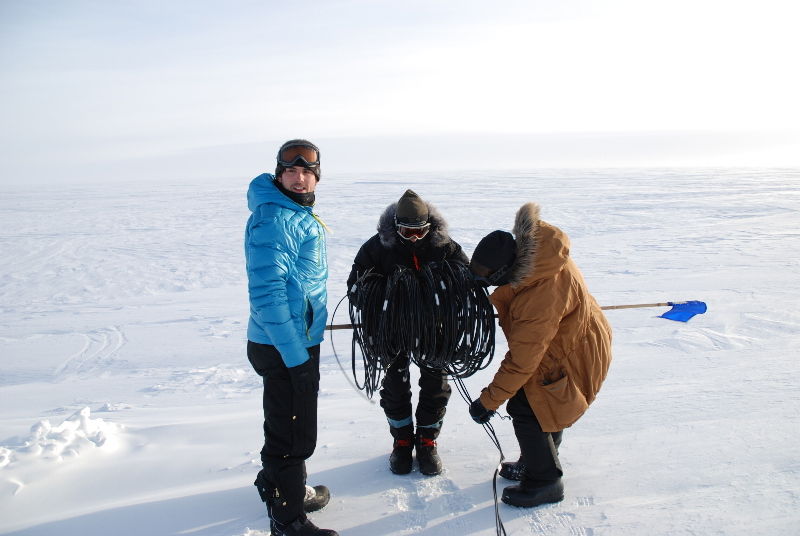Study: Fossil fuel methane emissions vastly underestimated

CORVALLIS, Ore. (KTVZ) – The global fossil fuel industry emits 25% to 40% more methane – a greenhouse gas and contributor to global warming – than previously thought, a study published Wednesday in Nature found.
This includes methane released during the extraction of fossil fuels, but also from leaks of natural gas from pipelines, factories and homes, according to the research team, led by University of Rochester researchers Benjamin Hmiel and Vasilii Petrenko and including Christo Buizert of Oregon State University.
The finding, made possible by studying air trapped inside ice cores drilled in Greenland, has important implications for climate research and efforts to reduce greenhouse gas emissions.
If human-caused methane emissions make up a larger part of the total, reducing emissions from human activities such as fossil fuel extraction and use will have a greater impact on curbing future global warming, the researchers said.
Methane emissions to the atmosphere have increased by approximately 150% over the past three centuries, but it has been difficult for researchers to determine exactly where these emissions originate in part because heat-trapping gases such as methane can be emitted naturally as well as from human activity.
Methane is the second largest human contribution to global warming, after carbon dioxide. Compared to carbon dioxide, methane is a more powerful greenhouse gas, but it is also has a much shorter lifetime in the atmosphere; it lasts an average of nine years in the atmosphere, while carbon dioxide takes thousands of years to remove from the climate system, the researchers said. This combination makes methane an especially suitable target for curbing emission levels in a short time frame.
“If we stopped emitting all carbon dioxide today, high carbon dioxide levels in the atmosphere would still persist for a long time,” Hmiel said. “Methane is important to study because if we make changes to our current methane emissions, it’s going to have an impact more quickly.”
The world’s nations have agreed in the Paris agreement to limit future warming to within 2 degrees Celsius (3.6 degrees Fahrenheit) by reducing emissions of greenhouse gases such as methane.
“By better understanding the sources of methane to the atmosphere, we can implement more targeted reduction strategies going forward,” Buizert said.
Methane emitted into the atmosphere falls into two categories based on its amount of carbon-14, a radioactive isotope. There is fossil methane, which is stored in sediments and underground reservoirs that no longer contain carbon-14 because the isotope has decayed. There is also biological methane, which is produced on the planet’s surface and contains carbon-14.
Biological methane can be released naturally from sources such as wetlands or via sources such as landfills, rice fields and livestock. Fossil methane, the focus of the Nature study, can be emitted via natural geologic seeps or as a result of humans extracting and using fossil fuels including oil, gas and coal.
“Think of the carbon-14 as the methane fingerprint,” Buizert said. “By measuring the carbon-14 level of methane in the atmosphere we can tell how much of came from fossil sources, and how much of it came from biological ones.”
Scientists can easily measure methane carbon-14 in the modern atmosphere, and they have a good idea of the total fossil methane sources. But how much of those fossil sources are natural, and how much are caused by humans impacting the environment?
“As a scientific community, we’ve been struggling to understand exactly how much methane we as humans are emitting into the atmosphere,” says Petrenko, a coauthor of the study. “We know that the fossil fuel component is one of our biggest component emissions, but it has been challenging to pin that down because in today’s atmosphere, the natural and anthropogenic components of the fossil emissions look the same, isotopically.”
To separate the natural and anthropogenic fossil methane components, an international team of researchers, including Buizert, traveled to the interior of the Greenland ice sheet to drill ice core samples that contain bubbles of air from the pre-industrial period (around the year 1750). The ice core samples act like time capsules: they contain air bubbles of ancient air trapped inside.
The researchers used a melting chamber to extract the ancient air from the ice and then measured the carbon-14 of the atmospheric methane. Because the carbon-14 has such a low concentration, they needed to melt around 2,000 pounds of ice to get enough air for a single measurement.
“These are the largest ice core samples ever measured; this has truly been a Herculean effort,” Buizert said.
The study measured changes to the carbon-14 of methane from the early 18th century – before the start of the Industrial Revolution – to the present day. The researchers found that almost all of the methane emitted to the atmosphere was biological in nature until about 1870. That’s when the fossil component began to rise rapidly. This timing coincides with a sharp increase in the use of fossil fuels.
The levels of naturally released fossil methane are about 10 times lower than previous research reported. Given the total fossil emissions measured in the atmosphere today, Hmiel and his colleagues deduce that the manmade fossil component is 25% to 40 % higher than previously thought.
To Hmiel, that’s actually good news. “I don’t want to get too hopeless on this, because my data does have a positive implication: Most of the methane emissions are anthropogenic, so we have more control. If we can reduce our emissions, it’s going to have more of an impact.”
The study was supported by the National Science Foundation and the David and Lucille Packard Foundation.